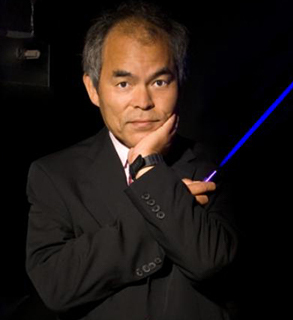 This year’s University of Utah Electrical and Computer Engineering Department’s Frontiers in Engineering Innovation: Judd Distinguished lecture Series featured Nobel Laureate Shuji Nakamura. Nakamura’s creation of the first bright gallium nitride (GaN) blue light-emitting diode (LED) light paved the way to creating the energy-efficient white LEDs found in homes today.
This year’s University of Utah Electrical and Computer Engineering Department’s Frontiers in Engineering Innovation: Judd Distinguished lecture Series featured Nobel Laureate Shuji Nakamura. Nakamura’s creation of the first bright gallium nitride (GaN) blue light-emitting diode (LED) light paved the way to creating the energy-efficient white LEDs found in homes today.
Friday, March 12, following introductions by College of Engineering Dean Richard B. Brown and ECE Distinguished Professor Gerald Stringfellow, Nakamura walked viewers through his career and mindset as he shaped the future of LED technology.
Since the introduction of red LEDs in the 1960s, large companies around the world had been investing hundreds of millions of dollars into blue LED research, but it was Nakamura who was able to crack the code.
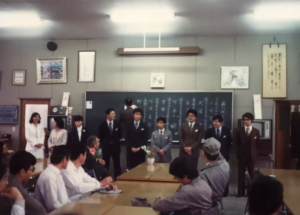
After earning his bachelor’s and master’s in electrical engineering from the University of Tokushima, Japan, he joined Nichia Chemical Industries Ltd. in 1979. Nakamura claims that Nichia’s founder and president, Nobuo Ogawa’s unwavering support, made his work possible.
“My research took a long time. I wasted a lot of money, but [Ogawa] always supported me. That’s the main reason I was able to invent blue LEDs,” Nakamura said.
Looking to gain a stronger background in Metal-Organic Chemical Vapor Deposition (MOCVD) and foreign experience, Nakamura spent a year at the University of Florida as a visiting research associate. When he returned to Japan in 1989, he went all-in on blue LED research and decided to pursue a Ph.D. which he could do in Japan, by publishing more than five scientific papers.
While attending the biggest conference in Japan, Nakamura noticed that when it came to blue LEDs, the majority of the community’s attention was on Zinc Selenide. At the same time, the alternative, Gallium Nitride, was brushed off. Presentations for Gallium Nitride were held in the smallest rooms with the fewest speakers, which also meant fewer papers were published on the topic.
“I never said that I could invent blue LED with Gallium Nitride, just that I wanted to publish a lot of papers. That’s why I selected Gallium Nitride,” said Nakamura.
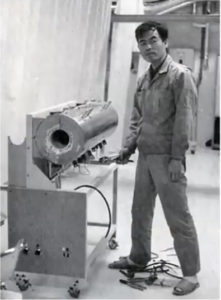
In pursuit of his Ph.D. Nakamura spent every morning modifying the MOCVD reactor and ran it up to five times every afternoon until he grew uniform, high-quality Gallium Nitride crystals.
In only three years, Nakamura had developed blue LEDs and the small company spent the next year preparing for mass production. After Nichia’s announcement of blue LEDs in 1993, green and white LEDs followed shortly behind.
By altering the composition of the emitting layer of LEDs, an entire spectrum of colors opened up. With four times the efficiency of fluorescent and 20 times the efficiency of incandescent lights, LEDs are now used in homes, as decoration, in cars, displays, agriculture and more.
Nakamura is now a professor of materials and electrical and computer engineering at the University of California, Santa Barbara, where he has been since 2000. In UCSB’s Solid State Lighting and Energy Electronics Center, Nakamura performs application-driven research focused on using Gallium Nitride in LEDs and Laser Diodes which he claims to be the “light of the future.” Laser Diodes are being used in laser projectors, headlights and even Google’s self-driving car.
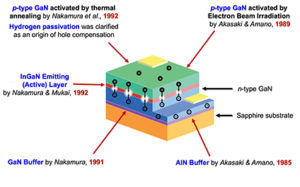
In addition to his Nobel Prize, Nakamura holds over 200 U.S. patents, more than 300 Japanese patents and has published more than 700 papers. He has also been awarded the Benjamin Franklin Medal Award, the Millennium Technology Prize, the Prince of Asturias Award for Technical Scientific Research and The Harvey Award. Nakamura was also elected fellow of the U.S. National Academy of Engineering and inducted into the National Inventors Hall of Fame. In 2015 he also received the Charles Stark Draper Prize for Engineering, the Global Energy Prize in Russia and will be receiving the Queen Elizabeth prize for engineering this year.
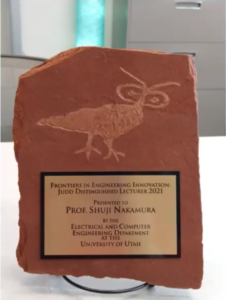 ECE professor Steve Blair ended the lecture by presenting Nakamura with a Frontiers in Engineering Innovation: Judd Distinguished Lecturer plaque featuring a “supernatural” owl. The owl represents wisdom in the Fremont culture, which is the earliest known culture of Utah.
ECE professor Steve Blair ended the lecture by presenting Nakamura with a Frontiers in Engineering Innovation: Judd Distinguished Lecturer plaque featuring a “supernatural” owl. The owl represents wisdom in the Fremont culture, which is the earliest known culture of Utah.
This lecture series is made possible through a generous endowment from Thomas and Mary Judd.